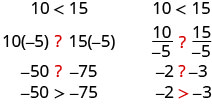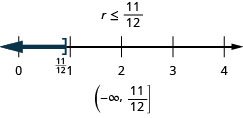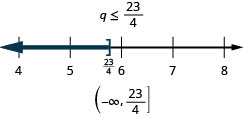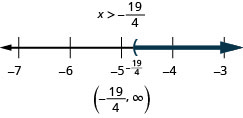1.5: Solve Linear Inequalities
- Page ID
- 109045
By the end of this section, you will be able to:
- Graph inequalities on the number line
- Solve linear inequalities
- Translate words to an inequality and solve
- Solve applications with linear inequalities
Solve
- \(x+3=5\)
- \(-x+3=5\)
- \(-2x-3=-9\)
Solution
- 2
- -2
- 3
Graph Inequalities on the Number Line
What number would make the inequality \(x>3\) true? Are you thinking, "\(x\) could be four"? That’s correct, but \(x\) could be 6, too, or 37, or even 3.001. Any number greater than three is a solution to the inequality \(x>3\). We show all the solutions to the inequality \(x>3\) on the number line by shading in all the numbers to the right of three, to show that all numbers greater than three are solutions. Because the number three itself is not a solution, we put an open parenthesis at three.
We can also represent inequalities using interval notation. There is no upper end to the solution to this inequality. In interval notation, we express \(x>3\) as \((3,\infty)\). The symbol \(\infty\) is read as “infinity.” It is not an actual number. Figure \(\PageIndex{1}\) shows both the number line and the interval notation.

We use the left parenthesis symbol, (, to show that the endpoint of the inequality is not included. The left bracket symbol, [, shows that the endpoint is included.
The inequality \(x\leq 1\) means all numbers less than or equal to one. Here we need to show that one is a solution, too. We do that by putting a bracket at \(x=1\). We then shade in all the numbers to the left of one, to show that all numbers less than one are solutions (Figure \(\PageIndex{2}\)). There is no lower end to those numbers. We write \(x\leq 1 \)in interval notation as \((−\infty,1]\). The symbol \(−\infty\) is read as “negative infinity.”

Figure \(\PageIndex{3}\) shows both the number line and interval notation.

The notation for inequalities on a number line and in interval notation use the same symbols to express the endpoints of intervals.
Graph each inequality on the number line and write in interval notation.
- \(x\geq −3\)
- \(x<2.5\)
- \(x\leq −\frac{3}{5}\)
- Answer
-
ⓐ
Solution to a. \( x \geq -3 \) Shade to the right of \(−3\), and put a bracket at \(−3\). 
Write in interval notation. \( [-3, \infty) \) ⓑ
Solution to b. \( x < 2.5 \) Shade to the left of 2.5 and put a parenthesis at 2.5. 
Write in interval notation. \( (-\infty, 2.5) \) ⓒ
Solution to c. \( x \leq -\dfrac{3}{5} \) Shade to the left of \(−\frac{3}{5}\), and put a bracket at \(−\frac{3}{5}\). 
Write in interval notation. \( \bigg( -\infty, \dfrac{3}{5}\bigg] \)
Graph each inequality on the number line and write in interval notation:
- \(x>2\)
- \(x\leq −1.5\)
- \(x\geq \frac{3}{4}\).
- Answer
-
ⓐ

ⓑ

ⓒ

Graph each inequality on the number line and write in interval notation:
- \(x\leq −4\)
- \(x\geq 0.5\)
- \(x<−\frac{2}{3}\).
- Answer
-
ⓐ

ⓑ

ⓒ

What numbers are greater than two but less than five? Are you thinking say, \(2.5,\space 3,\space 3\frac{2}{3},\space 4\)? We can represent all the numbers between two and five with the inequality \(2<x<5\). We can show \(2<x<5\) on the number line by shading all the numbers between two and five. Again, we use the parentheses to show the numbers two and five are not included. See Figure.

Graph each inequality on the number line and write in interval notation.
ⓐ \(−3<x<4\) ⓑ \(−6\leq x<−1\) ⓒ \(0\leq x\leq 2.5\)
- Answer
-
ⓐ
Solution to a. \(-3 < x < 4\) Shade between \(−3\) and 4.
Put a parentheses at \(−3\) and 4.
Write in interval notation. \( (-3,4) \) ⓑ
Solution to b. \( -6 \leq x < -1 \) Shade between \(−6\) and −1.
Put a bracket at \(−6\), and
a parenthesis at −1.
Write in interval notation. \( [-6,1) \) ⓒ
Solution to c. \( 0 \leq x \leq 2.5 \) Shade between 0 and 2.5.
Put a bracket at 0 and at 2.5.
Write in interval notation. \( [0, 2.5] \)
Graph each inequality on the number line and write in interval notation:
ⓐ \(−2<x<1\) ⓑ \(−5\leq x<−4\) ⓒ \(1\leq x\leq 4.25\)
- Answer
-
ⓐ

ⓑ

ⓒ

Graph each inequality on the number line and write in interval notation:
ⓐ \(−6<x<2\) ⓑ \(−3\leq x< −1\) ⓒ \(2.5\leq x\leq 6\)
- Answer
-
ⓐ

ⓑ

ⓒ

Solve Linear Inequalities
A linear inequality is much like a linear equation—but the equal sign is replaced with an inequality sign. A linear inequality is an inequality in one variable that can be written in one of the forms, \(ax+b<c\), \(ax+b\leq c\), \(ax+b>c\), or \(ax+b\geq c\).
A linear inequality is an inequality in one variable that can be written in one of the following forms where \(a, \, b,\) and \(c\) are real numbers and \(a≠0\):
\[ \begin{array} {llll} {ax+b<c,} &{ax+b\leq c,} &{ax+b>c,} &{ax+b\geq c.} \\ \nonumber \end{array}\]
When we solved linear equations, we were able to use the properties of equality to add, subtract, multiply, or divide both sides and still keep the equality. Similar properties hold true for inequalities.
We can add or subtract the same quantity from both sides of an inequality and still keep the inequality. For example:

Notice that the inequality sign stayed the same.
This leads us to the Addition and Subtraction Properties of Inequality.
For any numbers \(a, \, b,\) and \(c,\) if \(a<b\), then
\[\begin{array} {ll} {a+c<b+c} &{a−c<b−c} \\ {a+c>b+c} &{a−c>b−c} \\ \nonumber \end{array}\]
We can add or subtract the same quantity from both sides of an inequality and still keep the inequality
What happens to an inequality when we divide or multiply both sides by a constant?
Let’s first multiply and divide both sides by a positive number.

The inequality signs stayed the same.
Does the inequality stay the same when we divide or multiply by a negative number?

Notice that when we filled in the inequality signs, the inequality signs reversed their direction.
When we divide or multiply an inequality by a positive number, the inequality sign stays the same. When we divide or multiply an inequality by a negative number, the inequality sign reverses.
This gives us the Multiplication and Division Property of Inequality.
For any numbers \(a, \, b,\) and \(c,\)
\[\begin{array} {l} {\text{multiply or divide by a positive}} \\ \\ \space\space\space\space\text{if }a<b\text{ and }c>0\text{, then }ac<bc \text{ and }\frac{a}{c}<\frac{b}{c}. \\ \space\space\space\space\text{if }a>b\text{ and }c>0\text{, then }ac>bc \text{ and }\frac{a}{c}>\frac{b}{c}. \\ \\ \text{ multiply or divide by a negative } \\ \\ \space\space\space\space\text{if }a<b\text{ and }c<0\text{, then }ac>bc \text{ and }\frac{a}{c}>\frac{b}{c}.\\ \space\space\space\space\text{if }a>b\text{ and }c<0\text{, then }ac<bc \text{ and }\frac{a}{c}<\frac{b}{c}.\\ \nonumber \end{array}\]
When we divide or multiply an inequality by \(a\):
- positive number, the inequality stays the same.
- negative number, the inequality reverses.
Sometimes when solving an inequality, as in the next example, the variable ends upon the right. We can rewrite the inequality in reverse to get the variable to the left.
\[x>a \text{ has the same meaning as } a<x \nonumber \]
Think about it as “If Xander is taller than Andy, then Andy is shorter than Xander.”
Solve each inequality. Graph the solution on the number line, and write the solution in interval notation.
ⓐ \(x−\frac{3}{8}\leq \frac{3}{4}\) ⓑ \(9y<54\) ⓒ \(−15<\frac{3}{5}z\)
- Answer
-
ⓐ
Solution to a. 
Add 3838 to both sides of the inequality. 
Simplify. 
Graph the solution on the number line. 
Write the solution in interval notation. 
ⓑ
Solution to b. 
Divide both sides of the inequality by 9; since
9 is positive, the inequality stays the same.
Simplify. 
Graph the solution on the number line. 
Write the solution in interval notation. 
ⓒ
Solution to c. 
Multiply both sides of the inequality by \(\frac{5}{3}\).
Since \(\frac{5}{3}\) is positive, the inequality stays the same.
Simplify. 
Rewrite with the variable on the left. 
Graph the solution on the number line. 
Write the solution in interval notation. 
Solve each inequality, graph the solution on the number line, and write the solution in interval notation:
ⓐ \(p−\frac{3}{4}\geq \frac{1}{6}\) ⓑ \(9c>72\) ⓒ \(24\leq \frac{3}{8}m\)
- Answer
-
ⓐ

ⓑ

ⓒ

Solve each inequality, graph the solution on the number line, and write the solution in interval notation:
ⓐ \(r−\frac{1}{3}\leq \frac{7}{12}\) ⓑ \(12d\leq 60\) ⓒ \(−24<\frac{4}{3}n\)
- Answer
-
ⓐ

ⓑ

ⓒ

Be careful when you multiply or divide by a negative number—remember to reverse the inequality sign.
Solve each inequality, graph the solution on the number line, and write the solution in interval notation.
ⓐ \(−\frac{1}{3}m\geq \frac{6}{5}\) ⓑ \(\frac{n}{−2} \geq 8\)
- Answer
-
ⓐ
Solution to a. 
Divide both sides of the inequality by \(−\frac{1}{3}\).
Since \(−\frac{1}{3}\) is a negative, the inequality reverses.
Simplify. 
Graph the solution on the number line. 
Write the solution in interval notation. 
ⓑ
Solution to b. 
Multiply both sides of the inequality by \(−2\).
Since \(−2\) is a negative, the inequality reverses.
Simplify. 
Graph the solution on the number line. 
Write the solution in interval notation. 
Solve each inequality, graph the solution on the number line, and write the solution in interval notation:
ⓐ \(−8q<32\) ⓑ \(\frac{k}{−12} \leq 15\).
- Answer
-
ⓐ

ⓑ

Solve each inequality, graph the solution on the number line, and write the solution in interval notation:
ⓐ \(−7r\leq −70\) ⓑ \(\frac{u}{−4}\geq −16\).
- Answer
-
ⓐ

ⓑ

Most inequalities will take more than one step to solve. We follow the same steps we used in the general strategy for solving linear equations, but make sure to pay close attention when we multiply or divide to isolate the variable.
Solve the inequality \(6y\leq 11y+17\), graph the solution on the number line, and write the solution in interval notation.
Solution
 |
|
|---|---|
| Subtract 11y from both sides to collect the variables on the left. |
 |
| Simplify. |  |
| Divide both sides of the inequality by −5, and reverse the inequality. |
 |
| Simplify. |  |
| Graph the solution on the number line. |  |
| Write the solution in interval notation. |  |
Solve the inequality, graph the solution on the number line, and write the solution in interval notation: \(3q\geq 7q−23\).
- Answer
-

Solve the inequality, graph the solution on the number line, and write the solution in interval notation: \(6x<10x+19\).
- Answer
-

When solving inequalities, it is usually easiest to collect the variables on the side where the coefficient of the variable is largest. This eliminates negative coefficients and so we don’t have to multiply or divide by a negative—which means we don’t have to remember to reverse the inequality sign.
Solve the inequality \(8p+3(p−12)>7p−28\), graph the solution on the number line, and write the solution in interval notation.
- Answer
-
Solution to the example. \(8p+3(p−12)>7p−28\) Simplify each side as much as possible. Distribute. \(8p+3p−36>7p−28\) Combine like terms. \(11p−36>7p−28\) Subtract \(7p\) from both sides to collect the
variables on the left, since \(11>7\).\(11p−36−7p>7p−28−7p\) Simplify. \(4p−36>−28\) Add \(36\) to both sides to collect the
constants on the right.\(4p−36+36>−28+36\) Simplify. \(4p>8\) Divide both sides of the inequality by
\(4\); the inequality stays the same.\(\dfrac{4p}{4}>\dfrac{8}{4}\) Simplify. \(p>2\) Graph the solution on the number line. 
Write the solution in interval notation. \((2,\infty)\)
Solve the inequality \(9y+2(y+6)>5y−24\), graph the solution on the number line, and write the solution in interval notation.
- Answer
-

Solve the inequality \(6u+8(u−1)>10u+32\), graph the solution on the number line, and write the solution in interval notation.
- Answer
-

Just like some equations are identities and some are contradictions, inequalities may be identities or contradictions, too. We recognize these forms when we are left with only constants as we solve the inequality. If the result is a true statement, we have an identity. If the result is a false statement, we have a contradiction.
Solve the inequality \(8x−2(5−x)<4(x+9)+6x\), graph the solution on the number line, and write the solution in interval notation.
- Answer
-
Solution to the example. Simplify each side as much as possible. \(8x−2(5−x)<4(x+9)+6x\) Distribute. \(8x−10+2x<4x+36+6x\) Combine like terms. \(10x−10<10x+36\) Subtract \({\color{red}{10x}}\) from both sides to collect the variables on the left. \(10x−10\,{\color{red}{-\,10x}}<10x+36\,{\color{red}{-\,10x}}\) Simplify. \(−10<36\) The \(x\)'s are gone, and we have a true
statement.The inequality is an identity.
The solution is all real numbers.Graph the solution on the number line. 
Write the solution in interval notation. \((−\infty,\infty)\)
Solve the inequality \(4b−3(3−b)>5(b−6)+2b\), graph the solution on the number line, and write the solution in interval notation.
- Answer
-

Solve the inequality \(9h−7(2−h)<8(h+11)+8h\), graph the solution on the number line, and write the solution in interval notation.
- Answer
-

We can clear fractions in inequalities much as we did in equations. Again, be careful with the signs when multiplying or dividing by a negative.
Solve the inequality \(\frac{1}{3}a−\frac{1}{8}a>\frac{5}{24}a+\frac{3}{4}\), graph the solution on the number line, and write the solution in interval notation.
- Answer
-
Solution to the example. \(\frac{1}{3}a−\frac{1}{8}a>\frac{5}{24}a+\frac{3}{4}\) Multiply both sides by the LCD, 24,
to clear the fractions.\({\color{red}{24}}\left(\dfrac{1}{3}a−\dfrac{1}{8}a\right)>\,{\color{red}{24}}\left(\dfrac{5}{24}a+\dfrac{3}{4}\right)\) Simplify. \( 8a - 3a > 5a + 18 \) Combine like terms. \( 5a > 5a + 18\) Subtract \(5a\) from both sides to collect the
variables on the left.\( 5a \,{\color{red}{-\,5a}} > 5a \,{\color{red}{-\,5a}} + 18\) Simplify. \(0 > 18 \) The statement is false. The inequality is a contradiction.
There is no solution.Graph the solution on the number line. 
Write the solution in interval notation. There is no solution.
Solve the inequality \(\frac{1}{4}x−\frac{1}{12}x>\frac{1}{6}x+\frac{7}{8}\), graph the solution on the number line, and write the solution in interval notation.
- Answer
-

Solve the inequality \(\frac{2}{5}z−\frac{1}{3}z<\frac{1}{15}z−\frac{3}{5}\), graph the solution on the number line, and write the solution in interval notation.
- Answer
-

Key Concepts
- Inequalities, Number Lines, and Interval Notation
\(x>a \quad x\geq a\quad x<a\quad x\leq a\)

- Linear Inequality
- A linear inequality is an inequality in one variable that can be written in one of the following forms where a, b, and care real numbers and \(a\neq 0\):
\[ax+b<c, \qquad ax+b\leq c, \qquad ax+b>c, \qquad ax+b\geq c.\nonumber\]
- A linear inequality is an inequality in one variable that can be written in one of the following forms where a, b, and care real numbers and \(a\neq 0\):
- Addition and Subtraction Property of Inequality
- For any numbers a, b, and c, if a<b,thena<b,then
\[\begin{array} {ll} {a+c<b+c} &{a−c<b−c} \\ {a+c>b+c} &{a−c>b−c} \\ \end{array} \nonumber\]
- We can add or subtract the same quantity from both sides of an inequality and still keep the inequality.
- For any numbers a, b, and c, if a<b,thena<b,then
- Multiplication and Division Property of Inequality
- For any numbers a, b, and c,
\(\begin{array} {l} \text{multiply or divide by a }\textbf{positive} \\ \\ \space\space\space\space\space\space\space\text{if }a<b\text{ and }c>0,\text{ then } ac<bc\text{ and }\frac{a}{c}<\frac{b}{c}. \\ \space\space\space\space\space\space\space\text{if }a>b\text{ and }c>0,\text{ then } ac>bc\text{ and }\frac{a}{c}>\frac{b}{c}. \\ \text{multiply or divide by a }\textbf{negative} \\ \\ \space\space\space\space\space\space\space\text{if }a<b\text{ and }c<0,\text{ then } ac>bc\text{ and }\frac{a}{c}>\frac{b}{c}. \\ \space\space\space\space\space\space\space\text{if }a>b\text{ and }c<0,\text{ then } ac<bc\text{ and }\frac{a}{c}<\frac{b}{c}. \\ \end{array}\)
- For any numbers a, b, and c,

